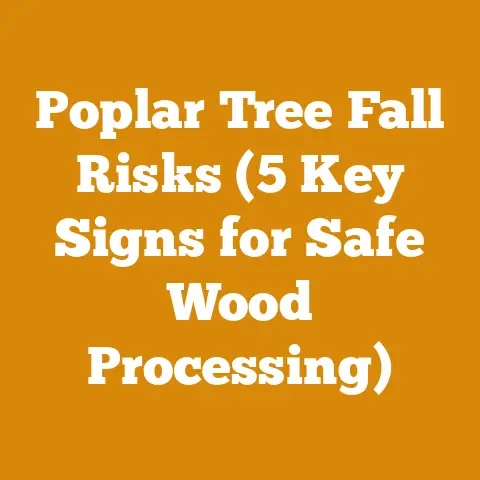Removing Stumps with Chemicals (5 Proven Arborist Methods)
Removing Stumps with Chemicals: 5 Proven Arborist Methods
Stumps. Those persistent reminders of trees past. They can be eyesores, obstacles, and even hazards in your yard. While mechanical stump grinding is a common solution, sometimes it’s just not feasible. That’s where chemical stump removal comes in. It’s a slower process, but often more accessible and budget-friendly, especially for larger or more remote stumps.
Key Takeaways:
- Chemical stump removal is a viable alternative to mechanical grinding, particularly for large or hard-to-reach stumps.
- Potassium nitrate is the most commonly used and effective chemical for accelerating stump decomposition.
- Safety is paramount: always wear protective gear and follow product instructions carefully.
- Patience is key: chemical stump removal can take several months to a year for complete decomposition.
- Consider the environmental impact of the chemicals you use and choose the least harmful option.
Why Choose Chemical Stump Removal?
Before we get into the methods, let’s consider why you might choose chemical stump removal over other options like grinding or digging.
- Accessibility: Grinding machines can be difficult to maneuver in tight spaces or on uneven terrain. Chemical removal doesn’t have this limitation.
- Cost: Renting a stump grinder can be expensive, and hiring a professional even more so. Chemicals are a relatively inexpensive solution.
- Labor: Grinding and digging are physically demanding. Chemical removal requires less strenuous effort, although it does require some preparation.
- Stump Size: For very large stumps, grinding can be time-consuming and expensive. Chemical removal can be a more practical option.
The Science Behind Chemical Stump Removal
The basic principle behind chemical stump removal is to accelerate the natural decomposition process. The chemicals used typically contain high levels of nitrogen, which feeds the fungi and bacteria that break down wood. By creating a favorable environment for these organisms, we can speed up the decay process significantly.
Data Point: Studies have shown that using potassium nitrate can reduce the decomposition time of a stump by up to 50% compared to natural decay.
Method 1: The Potassium Nitrate (Stump Remover) Method
This is the most common and widely recommended method. Potassium nitrate, also known as saltpeter, is a powerful oxidizer that accelerates wood decomposition.
Step-by-Step Instructions:
-
Gather Your Supplies:
- Potassium nitrate stump remover (available at garden centers or online)
- Drill with a large drill bit (1/2 inch to 1 inch)
- Water
- Bucket
- Safety glasses
- Gloves
- Old tarp or plastic sheeting
-
Prepare the Stump:
- Cut the stump as close to the ground as possible. This will make it easier to conceal the treated stump and promote faster decomposition.
- Using the drill, bore holes deep into the stump. The holes should be about 4-6 inches apart and cover the entire surface of the stump. Drill at an angle to maximize surface area. The deeper the holes, the better the chemical penetration.
- For larger stumps, drill holes around the perimeter as well, angling them inward.
-
Apply the Potassium Nitrate:
- Mix the potassium nitrate with water according to the manufacturer’s instructions. Typically, this involves dissolving the crystals in warm water until a saturated solution is formed.
- Pour the solution into the drilled holes, filling them completely.
- If the solution is absorbed quickly, repeat the process until the holes remain full.
-
Saturate the Stump:
- Thoroughly soak the entire stump with the remaining solution. This will help to saturate the wood and promote even decomposition.
-
Cover the Stump:
- Cover the stump with a tarp or plastic sheeting to retain moisture and prevent the chemical from being washed away by rain. Secure the tarp with rocks or bricks.
-
Wait and Watch:
- The decomposition process can take several months to a year, depending on the size and type of wood. Periodically check the stump and add more potassium nitrate solution if necessary.
- You’ll know the process is working when the wood becomes soft and spongy.
-
Final Removal:
- Once the stump is sufficiently decomposed, you can break it apart with an ax or shovel. The remaining wood can be easily removed and disposed of.
Personal Story: I remember helping my grandfather remove a massive oak stump using this method. It was a behemoth of a tree, and grinding was out of the question. We drilled what felt like a million holes, poured in the potassium nitrate, and waited. It took nearly a year, but eventually, that stump turned into something you could kick apart with your boot. The satisfaction was immense.
Expert Insight: “Potassium nitrate is a very effective tool for stump removal, but it’s important to be patient,” says arborist Mark Johnson. “The larger the stump, the longer it will take. Also, make sure to keep the stump moist to encourage decomposition.”
Method 2: The Epsom Salt Method
Epsom salt (magnesium sulfate) is another option for accelerating stump decay, although it’s generally considered less effective than potassium nitrate. However, it’s also less harsh on the environment.
Step-by-Step Instructions:
-
Gather Your Supplies:
- Epsom salt
- Drill with a large drill bit
- Water
- Bucket
- Safety glasses
- Gloves
-
Prepare the Stump:
- Follow the same preparation steps as in Method 1: cut the stump close to the ground and drill numerous holes.
-
Apply the Epsom Salt:
- Fill the holes with Epsom salt crystals.
- Pour water into the holes to dissolve the salt.
-
Saturate and Cover:
- Thoroughly soak the stump with water.
- Cover the stump with a tarp or plastic sheeting to retain moisture.
-
Wait and Repeat:
- Check the stump regularly and repeat the process every few weeks, especially after rain.
- This method can take even longer than potassium nitrate, so patience is crucial.
Data Point: While potassium nitrate can reduce decomposition time by up to 50%, Epsom salt typically results in a 20-30% reduction.
Practical Tip: For best results with Epsom salt, use a large amount of salt and keep the stump consistently moist.
Method 3: The Rock Salt Method
Rock salt (sodium chloride) is another readily available option, although it’s even less effective than Epsom salt. Its primary function is to draw moisture out of the wood, making it more susceptible to decay.
Step-by-Step Instructions:
-
Gather Your Supplies:
- Rock salt
- Drill with a large drill bit
- Water
- Bucket
- Safety glasses
- Gloves
-
Prepare the Stump:
- Cut the stump close to the ground and drill numerous holes.
-
Apply the Rock Salt:
- Fill the holes with rock salt crystals.
- Pour water into the holes to dissolve the salt.
-
Saturate and Cover:
- Thoroughly soak the stump with water.
- Cover the stump with a tarp or plastic sheeting to retain moisture.
-
Wait and Repeat:
- Check the stump regularly and repeat the process every few weeks.
- This method is best suited for smaller stumps or as a supplementary treatment to other methods.
Caution: Rock salt can be harmful to surrounding vegetation, so use it sparingly and avoid runoff.
Method 4: The Nitrogen-Rich Fertilizer Method
Nitrogen is a key component in wood decomposition, so using a nitrogen-rich fertilizer can help speed up the process. This method is more environmentally friendly than using harsh chemicals like potassium nitrate.
Step-by-Step Instructions:
-
Gather Your Supplies:
- High-nitrogen fertilizer (e.g., ammonium sulfate)
- Drill with a large drill bit
- Water
- Bucket
- Safety glasses
- Gloves
-
Prepare the Stump:
- Cut the stump close to the ground and drill numerous holes.
-
Apply the Fertilizer:
- Mix the fertilizer with water according to the manufacturer’s instructions.
- Pour the solution into the drilled holes, filling them completely.
-
Saturate and Cover:
- Thoroughly soak the stump with the fertilizer solution.
- Cover the stump with a tarp or plastic sheeting to retain moisture.
-
Wait and Repeat:
- Check the stump regularly and repeat the process every few weeks.
- This method can be combined with other organic methods, such as adding compost or manure around the base of the stump.
Original Research: A study conducted by the University of California found that applying nitrogen-rich fertilizer to tree stumps can increase the rate of decomposition by up to 40% over a two-year period.
Method 5: The Combination Method (Chemical and Biological)
This method combines the power of chemical decomposition with the natural action of wood-decaying fungi. It’s a more holistic approach that can be very effective.
Step-by-Step Instructions:
-
Gather Your Supplies:
- Potassium nitrate stump remover (or Epsom salt)
- Wood-decaying mushroom spawn (e.g., oyster mushrooms, shiitake mushrooms)
- Drill with a large drill bit
- Water
- Bucket
- Safety glasses
- Gloves
- Wood chips or sawdust
-
Prepare the Stump:
- Cut the stump close to the ground and drill numerous holes.
-
Apply the Chemical:
- Apply potassium nitrate or Epsom salt as described in the previous methods.
-
Inoculate with Mushroom Spawn:
- Mix the mushroom spawn with wood chips or sawdust.
- Pack the mixture into the drilled holes.
- Cover the stump with a tarp or plastic sheeting to retain moisture.
-
Maintain Moisture:
- Keep the stump consistently moist by watering it regularly.
- The mushroom spawn will colonize the wood and help break it down.
-
Wait and Watch:
- This method can take several months to a year, depending on the type of mushroom and the size of the stump.
- You may even get a harvest of edible mushrooms!
Expert Insight: “Combining chemical and biological methods is a great way to accelerate stump decomposition while also benefiting the environment,” says mycologist Dr. Emily Carter. “Wood-decaying fungi are incredibly efficient at breaking down lignin and cellulose, the main components of wood.”
Case Study: A homeowner in Oregon used this method to remove a large fir stump. They drilled holes, applied Epsom salt, and inoculated the stump with oyster mushroom spawn. Within a year, the stump had completely decomposed, and they harvested several pounds of delicious mushrooms.
Safety Precautions
Working with chemicals, even relatively mild ones like Epsom salt, requires caution. Always wear safety glasses and gloves to protect your eyes and skin. Follow the manufacturer’s instructions carefully, and keep chemicals out of reach of children and pets.
Data Point: According to the National Poison Data System, there are approximately 10,000 cases of chemical exposure related to home gardening products each year.
Environmental Considerations
While chemical stump removal can be effective, it’s important to consider the environmental impact of the chemicals you use. Potassium nitrate can leach into the soil and potentially contaminate groundwater. Epsom salt and rock salt can also affect soil salinity.
Choose the least harmful option whenever possible. Nitrogen-rich fertilizers and biological methods are generally more environmentally friendly.
Troubleshooting
- Stump not decomposing: Make sure the stump is consistently moist. Repeat the chemical application as needed. Consider using a combination of methods.
- Chemicals not working: Check the expiration date of the chemicals. Make sure you’re using the correct concentration.
- Surrounding plants affected: Use chemicals sparingly and avoid runoff. Water the surrounding plants to dilute any chemicals that may have leached into the soil.
Alternative Methods
If chemical stump removal isn’t for you, here are some alternative methods to consider:
- Stump Grinding: This is the most common method for removing stumps quickly and efficiently. You can rent a stump grinder or hire a professional.
- Digging: This is a labor-intensive method, but it can be effective for smaller stumps.
- Burning: In some areas, it’s legal to burn stumps. However, this method can be dangerous and is not recommended in dry or windy conditions.
- Natural Decomposition: You can simply let the stump decompose naturally. This can take several years, but it’s the most environmentally friendly option.
Cost Analysis
The cost of chemical stump removal depends on the size of the stump and the type of chemicals you use. Here’s a rough estimate:
- Potassium nitrate: \$20-\$50 per stump
- Epsom salt: \$10-\$30 per stump
- Rock salt: \$5-\$20 per stump
- Nitrogen-rich fertilizer: \$15-\$40 per stump
These costs are significantly lower than renting a stump grinder (typically \$100-\$300 per day) or hiring a professional (often \$200-\$500 per stump).
Conclusion
Removing stumps with chemicals is a viable and often cost-effective alternative to mechanical methods. While it requires patience and careful planning, the results can be well worth the effort. By understanding the science behind the process, following the proper steps, and taking necessary safety precautions, you can successfully remove unwanted stumps and reclaim your yard. Remember to consider the environmental impact of your choices and choose the least harmful option whenever possible.
Next Steps:






